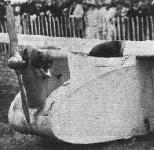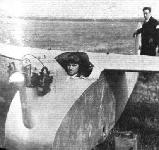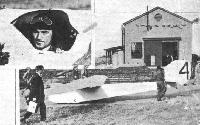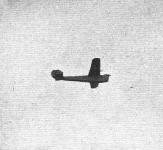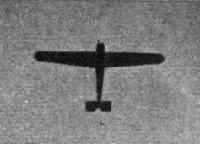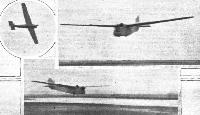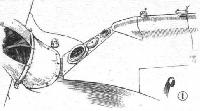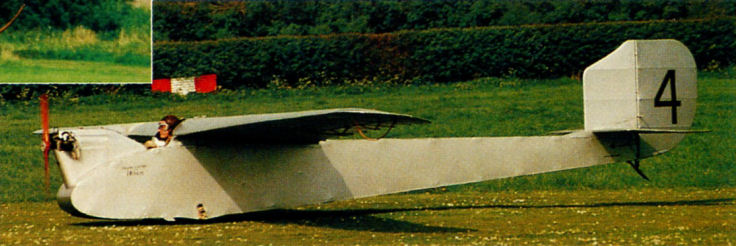
English Electric Wren
Концепции сверхлегкого самолета и мотопланера, ныне активно развивающейся, уже 90 лет. В 1921 году В. О. Мэннинг из фирмы "English Electric", ранее занимавшийся разведывательными летающими лодками, переключился на создание легких самолетов.
Имевшиеся в наличии маломощные двигатели чаще всего являлись переделанными мотоциклетными моторами. Самолет Мэннинга English Electric Wren имел оригинальную конструкцию - масса пустой машины составляла всего 105 кг. Первоначально самолет был оснащен двухцилиндровым мотоциклетным двигателем A.B.C. объемом 398 см3 и неплохо летал, развивая максимальную скорость 80 км/ч.
Еще несколько производителей построили легкие самолеты после того, как герцог Сатерленд, заместитель госсекретаря по авиации, назначил приз в 500 фунтов стерлингов за самый экономичный легкий одноместный аэроплан британской постройки. В апреле 1921 года интерес к этим машинам подогрело заявление газеты "Дейли Мейл", пообещавшей приз в 1000 фунтов создателю мотопланера с мотором объемом не более 750 см3, который пролетит максимальное расстояние на одном имперском галлоне (4,5 л) бензина. На соревнованиях, прошедших в Лимпне в октябре 1923 года, Wren боролся за эту награду с самолетом ANEC. Обе машины пролетели одинаковое расстояние - 140,8 км. Один Wren был построен для Министерства авиации еще в 1921 году, а другие два - для участия в состязаниях в Лимпне. Один из них, после проведенного "English Electric" ремонта и повторного облета в 1957 году, ныне находится в коллекции Шаттлуорта.
ТАКТИКО-ТЕХНИЧЕСКИЕ ХАРАКТЕРИСТИКИ
English Electric Wren
Тип: одноместный сверхлегкий моноплан
Силовая установка: один поршневой двигатель A.B.C. объемом 398 см3
Летные характеристики: максимальная скорость 80 км/ч; крейсерская скорость 66 км/ч
Масса: пустого 105 кг; максимальная взлетная 191 кг
Размеры: размах крыла 11,28 м; длина 7,39 м; высота 1,45 м
Описание:
- English Electric Wren
- Flight, August 1923
THE "WREN" LIGHT 'PLANE
Фотографии
-
Мировая Авиация 84
Самолет English Electric Wren был разработан под требования Министерства авиации от 1922 года на сверхлегкий УТС. Мотор - ABC мощностью 3 л. с. (2,6 кВт).
-
Aeroplane Monthly 1993-10 / M.Oakey - Grapevine
Twang! The Shuttleworth Collection’s Summer Air Fete at Old Warden on August 1, 1993 was considerably enlivened by the bungee-launching of the English Electric Wren. Thanks to an energetic group of pullers and a stout rubber rope the engagingly underpowered Lympne Trials ultralight made three hops with Bill Bowker aboard. Six volunteers provided the necessary impetus - next time they plan to try eight, and a lighter pilot.
-
Flight 1923-04 / Flight
Регистрационный номер: J6973 [8] THE "WREN": This astonishing light 'plane has been designed by Mr. W. O. Manning and built by the English Electric Co., of Preston, Lancashire. The engine is a 400 c.c. A.B.C. motor-cycle engine developing about 7 h.p. at 4,000 r.p.m. When the "Wren" was flown by Squadron Leader Maurice Wright last week-end, the engine was never opened out fully.
-
Flight 1923-08 / Flight
THE "WREN" LIGHT 'PLANE, FITTED WITH 3 H.P. A.B.C. ENGINE: Three-quarter front view.
-
Jane's All the World Aircraft 1980 / Encyclopedia of Aviation - 1. Chronology
Регистрационный номер: J6973 [8] English Electric Wren (8 October 1923).
-
Jane's All the World Aircraft 1980 / Encyclopedia of Aviation - Aircraft A-Z - v3
English Electric Wren.
-
Aeroplane Monthly 1984-10 / R.Riding - English Electric Wren /British pre-war ultralights/ (43)
Регистрационный номер: J6973 [8] The first Wren seen at the RAF Pageant at Hendon on June 30, 1923. Though its ABC engine had oiled up badly, Longton put up an impressive show. The Wren was numbered 11 for inclusion in the New Types Park. This first aircraft had an extra 2° wing dihedral.
-
Aeroplane Monthly 1984-10 / R.Riding - English Electric Wren /British pre-war ultralights/ (43)
Регистрационный номер: J6973 [8] Another view of the first Wren at the RAF Pageant at Hendon in June 1930. Apart from having more wing dihedral than the Lympne Wrens, J6973's wings were swung slightly more forward so that the leading edge was almost at right angles to the centre line of the machine. Before this adjustment the centre of gravity was too far forward.
-
Мировая Авиация 95
Регистрационный номер: J6973 [8] 15 октября 1923г.: 27 самолетов, в том числе и этот English Electric Wren (призер в номинации на самую высокую топливную экономичность), приняли участие в первом в Великобритании соревновании легких самолетов в поселке Лимпн, графство Кент.
-
Aeroplane Monthly 1984-10 / R.Riding - English Electric Wren /British pre-war ultralights/ (43)
Регистрационный номер: J6973 [8] The first Wren was built for the Air Ministry and taken over by them during 1923 as J6973. It made its first full flight on April 8, 1923.
-
Flight 1923-08 / Flight
Регистрационный номер: J6973 [8] The "Wren" Light 'Plane: Three-quarter rear view.
-
Flight 1923-10 / Flight
The Competition "Wren": The A.B.C. engine is neatly cowled-in, and the instrument board is mounted just in front of the pilot, on the sloping back of the engine fairing, where it is easily visible.
-
Flight 1923-07 / Flight
Another "close-up" of the other extreme. The 3 h.p. A.B.C. engine in the "Wren "light 'plane.
-
Aeroplane Monthly 1984-10 / R.Riding - English Electric Wren /British pre-war ultralights/ (43)
Flt Lt Longton runs up Wren No 4’s ABC engine at Lympne, his face a study in concentration.
-
Flight 1936-04 / Flight
The English Electric Company's Wren, which flew strongly on the power of a 400 c.c. A.B.C. motor cycle engine.
-
Flight 1923-10 / Flight
Longton wheeling out his "Wren" at Lympne. Inset, "listening" to his engine.
-
Aeroplane Monthly 1984-10 / R.Riding - English Electric Wren /British pre-war ultralights/ (43)
Flt Lt Longton's Wren seen at the Daily Mail lightplane trials at Lympne in October 1923.
-
Air Pictorial 1957-03
Top photograph is of a Single-seat English Electric Wren, originally built in 1922, and recently rebuilt and flying again. Engine is a 398-c.c. A.B.C. flat-twin motor cycle unit which gives a top speed of 50 m.p.h.
-
Aeroplane Monthly 1984-10 / R.Riding - English Electric Wren /British pre-war ultralights/ (43)
Flt Lt Longton's Wren seen flying at Old Warden 50 years later.
-
Aeroplane Monthly 1981-09 / P.Jarrett - Plane Speaking
The Wren at altitude during the Old Warden display on September 30, 1979.
-
Мировая Авиация 120
English Electric Wren с номером "4" на самом деле был третьим и последним построенным самолетом. В 1950-х годах он был отремонтирован с использованием элементов от второй машины. В 1957 году П. Хиллвуд снова поднял его в воздух. Ныне самолет принадлежит коллекции Шаттлуорта.
Now flying again is this English Electric Wren - a product of the company in its first period of aircraft design. It was built in 1922 and has a 386-c.c. A.B.C. engine. -
Flight 1923-10 / Flight
THE AMAZING "WREN": Major Wright flying No. 3 at Lympne.
-
Flight 1924-09 / Flight
ONE OF TWO PRIZE-WINNERS AT LYMPNE: Flight-Lieut. Longton, flying the "Wren" No. 4.
-
Flight 1923-06 / Flight
Three views of the "Wren" in flight over Lytham sands recently.
-
Flight 1923-07 / Flight
Регистрационный номер: J6973 [8] AT THE R.A.F. PAGEANT: The Wren "Troop Carrier," with mechanics holding it back, dashes past the Royal Box. Inset: the "troop" makes a safe landing flying round the aerodrome.
-
Flight 1926-09 / Flight
400 c.c. ONLY: The English Electric Co.'s "Wren," which in 1923 tied with the A.N.E.C. for first prize. Mileage 87-5 miles per gallon.
-
Flight 1923-10 / Flight
THE NEW "WREN": Two views, taken at the Preston works of the English Electric Co., of the first of the competition "Wrens," which has now been finished and tested. This machine flies quite well on half throttle.
-
Flight 1923-10 / Flight
LIGHT 'PLANES AT LYMPNE: Some interesting constructional features: 1, the rear sloping edge of the engine mounting fairing on the "Wrens" is very ingeniously utilised as an instrument-board. The various dials are immediately in front of the pilot, and as they are out in the open they are well illuminated and consequently easily read.
-
Flight 1923-08 / Flight
The "Wren" Light 'Plane 3 hp A.B.C. Engine
- Фотографии












